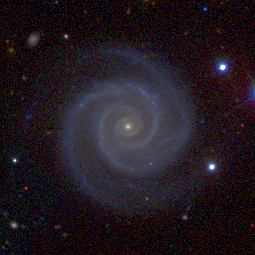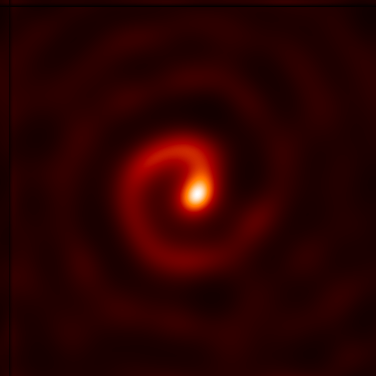Page 1 of 1
APOD: The Extraordinary Spiral in LL Pegasi (2016 Dec 11)
Posted: Sun Dec 11, 2016 5:07 am
by APOD Robot
 The Extraordinary Spiral in LL Pegasi
Explanation:
The Extraordinary Spiral in LL Pegasi
Explanation: What created the strange spiral structure on the left? No one is sure, although it is likely related to a star in a
binary star system entering the
planetary nebula phase, when its outer atmosphere is ejected. The
huge spiral spans about a third of a
light year across and, winding four or five complete turns, has a regularity that is without precedent. Given the expansion rate of the
spiral gas, a new layer must appear about every 800 years, a close match to the time it takes for the two stars to orbit each other. The star system that created it is most commonly known as
LL Pegasi, but also AFGL 3068. The unusual structure itself has been cataloged as
IRAS 23166+1655. The
featured image was taken in near-
infrared light by the
Hubble Space Telescope. Why the
spiral glows is itself a mystery, with a leading hypothesis being illumination by light reflected from nearby stars.
[/b]
Re: APOD: The Extraordinary Spiral in LL Pegasi (2016 Dec 11)
Posted: Sun Dec 11, 2016 11:58 am
by Ann
Highly regular spiral galaxy NGC 2857.
Photo: European Southern Observatory -
NASA/IPAC Extragalactic Database
LL Pegasi is a very interesting object. Amazingly, its spiral has made at least four turns around the center. I can't think of any galaxy that does anything remotely similar. NGC 2857 is the most regular spiral I can think of offhand, but for the numbers of turns it makes with its spiral arms, it is no match for LL Pegasi.
When I first looked at today's APOD, I was impressed at the blue color of the spiral "arm". But then I noticed that the picture is an infrared image, and the blue color is mapped.
It is indeed interesting that the spiral glows, at least in infrared, while the star itself is apparently invisible in this image.
Ann
Re: APOD: The Extraordinary Spiral in LL Pegasi (2016 Dec 11)
Posted: Sun Dec 11, 2016 12:52 pm
by starsurfer
Could it glow possibly from ERE processes?
Also the structure of the nebula around CW Leonis looks a bit similar.
Re: APOD: The Extraordinary Spiral in LL Pegasi (2016 Dec 11)
Posted: Sun Dec 11, 2016 3:26 pm
by ta152h0
a spinning neutron star dragging " stuff " around ? There is stuff out there that cannot be detected ! Yet !
Re: APOD: The Extraordinary Spiral in LL Pegasi (2016 Dec 11)
Posted: Sun Dec 11, 2016 4:28 pm
by neufer
ta152h0 wrote:
a spinning neutron star dragging " stuff " around ? There is stuff out there that cannot be detected ! Yet !
- No one said anything about "a neutron star."
https://en.wikipedia.org/wiki/IRAS_23166%2B1655 wrote:
<<IRAS 23166+1655 is thought to be a preplanetary nebula surrounding LL Pegasi (AFGL 3068), a binary system that includes
an extreme carbon star. The pair is hidden by the dust cloud ejected from the carbon star and is only visible in infrared light.
The nebula displays an unusual spiral shape. The shape is thought to be formed through the interaction between the stellar companion and the carbon star, as has been seen in other binary systems, although not with such a precise geometric form. The distance between spiral layers is consistent with estimates of the pair's orbital period based on their apparent angular separation. Some say that, due to the regular appearance of spiral arms, the orbital period between LL Pegasi A (IRAS 23166+1655 A) and LL Pegasi B (IRAS 23166+1655 B) have an orbital period of c. 800 years.>>
Re: APOD: The Extraordinary Spiral in LL Pegasi (2016 Dec 11)
Posted: Sun Dec 11, 2016 4:40 pm
by ta152h0
as my title describes, got schooled
Re: APOD: The Extraordinary Spiral in LL Pegasi (2016 Dec 11)
Posted: Sun Dec 11, 2016 4:49 pm
by neufer
Are ~100 year wiggles in the LL Pegasi Spiral
- indicative of yet a third star

https://www.youtube.com/watch?v=2hNWCI-9n8Q
Re: APOD: The Extraordinary Spiral in LL Pegasi (2016 Dec 11)
Posted: Sun Dec 11, 2016 4:57 pm
by Chris Peterson
Ann wrote:LL Pegasi is a very interesting object. Amazingly, its spiral has made at least four turns around the center. I can't think of any galaxy that does anything remotely similar.
Of course, there is no reason to make any association between this object and galaxies. Other than a superficial resemblence, the underlying mechanism creating the spiral is entirely different. In this nebula, the material that makes up the spiral arms is actually moving outward- like water from a rotating sprinkler. In a galaxy, nothing is moving outward- that's an illusion like we see with a pinwheel.
Re: APOD: The Extraordinary Spiral in LL Pegasi (2016 Dec 11)
Posted: Sun Dec 11, 2016 6:00 pm
by Ann
Chris Peterson wrote:Ann wrote:LL Pegasi is a very interesting object. Amazingly, its spiral has made at least four turns around the center. I can't think of any galaxy that does anything remotely similar.
Of course, there is no reason to make any association between this object and galaxies. Other than a superficial resemblence, the underlying mechanism creating the spiral is entirely different. In this nebula, the material that makes up the spiral arms is actually moving outward- like water from a rotating sprinkler. In a galaxy, nothing is moving outward- that's an illusion like we see with a pinwheel.
Good point, Chris. Of course, I can't help comparing LL Pegasi with a spiral galaxy simply because I'm so fascinated by spiral galaxies.
But LL Pegasi can also be compared with stars, because there are other stars that make pinwheel patterns, like the star (probably
WR 104) at left. I take it that WR 104 (and other
WR stars like it) emit gas that moves outwards, forming spiral patterns. Still, LL Pegasi is outstanding in its regularity.
Ann
Re: APOD: The Extraordinary Spiral in LL Pegasi (2016 Dec 11)
Posted: Sun Dec 11, 2016 6:15 pm
by Chris Peterson
Ann wrote:Still, LL Pegasi is outstanding in its regularity.
It is outstanding because of its rarity, but it's the rarity itself I find remarkable. It seems like such structures should be common. All you need is a uniformly rotating body (the Universe is full of those), the uniform ejection of gas (also common), and something to introduce asymmetry (such as a double star system... again, very common). Why don't we see more nebulas like this given how common the individual requirements are?
A Binary-Induced Pinwheel Outflow from the Extreme Carbon Star, AFGL 3068
Posted: Sun Dec 11, 2016 6:39 pm
by Case
M. Morris et al. wrote:Figure 2. Keck adaptive optics images of AFGL 3068 in 3 near-IR filters. Two sources are apparent, the slightly diffuse one to the west probably being the highly obscured, mass-losing star, and the one to the east being a much less obscured companion at a projected distance of 109 AU at 1 kpc. The first Airy ring in the point spread function for these images has a trefoil pattern which is most evident in the H image of the eastern source. (The ”PAH” filter was used to provide a narrow-band sampling of the 3.3 m continuum, since the usual wideband filters saturated on this strong source.)
Re: APOD: The Extraordinary Spiral in LL Pegasi (2016 Dec 11)
Posted: Mon Dec 12, 2016 4:09 am
by Boomer12k
Interesting... must not be close enough... or maybe the companion is not a white dwarf... so it does not become a Type 1a Supernova.... maybe the companion draws the ejected gas after it... and splays it about... but by the time the gas trail is where the star should be... the star is not, and so the gas continues outward....
:---[===] *
Re: APOD: The Extraordinary Spiral in LL Pegasi (2016 Dec 11)
Posted: Mon Dec 12, 2016 3:05 pm
by DavidLeodis
Is the extremely bright object with the colourful diffraction spikes there by chance alignment and has nothing to do with the spiral?
Re: APOD: The Extraordinary Spiral in LL Pegasi (2016 Dec 11)
Posted: Mon Dec 12, 2016 4:10 pm
by Ann
DavidLeodis wrote:Is the extremely bright object with the colourful diffraction spikes there by chance alignment and has nothing to do with the spiral?
My software, Guide, has found a 12th magnitude orange star right next to LL Pegasi,3UC215-331878. Perhaps that is the star that looks so overwhelmingly bright in yesterday's APOD. Whether this star has anything at all to do with LL Pegasi is anyone's guess, or at least I am absolutely stumped.
Remember that the APOD is apparently an infrared image. An orange star would look brighter in infrared than in visual light.
Ann
Re: APOD: The Extraordinary Spiral in LL Pegasi (2016 Dec 11)
Posted: Mon Dec 12, 2016 4:51 pm
by Chris Peterson
Ann wrote:DavidLeodis wrote:Is the extremely bright object with the colourful diffraction spikes there by chance alignment and has nothing to do with the spiral?
My software, Guide, has found a 12th magnitude orange star right next to LL Pegasi,3UC215-331878. Perhaps that is the star that looks so overwhelmingly bright in yesterday's APOD. Whether this star has anything at all to do with LL Pegasi is anyone's guess, or at least I am absolutely stumped.
Remember that the APOD is apparently an infrared image. An orange star would look brighter in infrared than in visual light.
The image is bicolor, near IR (not much different from red) and broad visual, centered on yellow.
I doubt that the bright star in the image is anywhere near the nebula.
Re: APOD: The Extraordinary Spiral in LL Pegasi (2016 Dec 11)
Posted: Mon Dec 12, 2016 5:10 pm
by Case
DavidLeodis wrote:Is the extremely bright object with the colourful refraction spikes there by chance alignment and has nothing to do with the spiral?
“The bright object to the right is a star
much closer to Earth.” -
Wikipedia
That star is catalogued as USNO-A2 1050-20631058 with magnitude 12.75 in
Sky-map.org
That star is catalogued as GSC 01713-00903 with magnitude (V) 12.21 in
Simbad/Guide Star Catalog,
ans also as UCAC3 215-331878 (Ann’s ID) in the Third
USNO CCD Astrograph Catalog.
Re: APOD: The Extraordinary Spiral in LL Pegasi (2016 Dec 11)
Posted: Mon Dec 12, 2016 9:25 pm
by neufer
Ann wrote:
Still, LL Pegasi is outstanding in its regularity.
Chris Peterson wrote:
It is outstanding because of its rarity, but it's the rarity itself I find remarkable. It seems like such structures should be common. All you need is a uniformly rotating body (the Universe is full of those), the uniform ejection of gas (also common), and something to introduce asymmetry (such as a double star system... again, very common). Why don't we see more nebulas like this given how common the individual requirements are?
Probably because the spiral material is carbon from the (rare) carbon star that is intertwined with the preplanetary nebula in the orbital plane.
Re: APOD: The Extraordinary Spiral in LL Pegasi (2016 Dec 11)
Posted: Mon Dec 12, 2016 10:08 pm
by DavidLeodis
Thanks all for your help with my query about the extremely bright star

.
Re: APOD: The Extraordinary Spiral in LL Pegasi (2016 Dec 11)
Posted: Tue Dec 13, 2016 12:43 am
by edhume
Did anyone see Hale Bopp? The spiral structure of IRAS 23166+1655 reminds me of what I saw in 1997 when we hiked through the snow to our observatory to see Comet Hale Bopp in our club’s 16-inch Cave Newtonian. The spiral structure we saw that night blew me away. It even impressed my seven-year-old daughter. The spiral structure of IRAS 23166+1655 caused that 20-year-old memory to come shooting up. The only thing is, because of the asymmetry of insolation we saw only fragments of the spiral. It was unique, though. A treasured memory!
Re: APOD: The Extraordinary Spiral in LL Pegasi (2016 Dec 11)
Posted: Tue Dec 13, 2016 3:14 am
by neufer
edhume wrote:
Did anyone see Hale Bopp? The spiral structure of IRAS 23166+1655 reminds me of what I saw in 1997 when we hiked through the snow to our observatory to see Comet Hale Bopp in our club’s 16-inch Cave Newtonian. The spiral structure we saw that night blew me away. It even impressed my seven-year-old daughter. The spiral structure of IRAS 23166+1655 caused that 20-year-old memory to come shooting up. The only thing is, because of the asymmetry of insolation we saw only fragments of the spiral. It was unique, though. A treasured memory!
http://www.racingshadow.com/CometMet/Hale-Bopp/Hale-Bopp.html wrote:
Comet C/1995 Hale-Bopp Archive
Observations in April 1997 (Julian Taylor, Oxted)
Note the jets of material being ejected by the nucleus being swept into a spiral as the nucleus rotates anticlockwise. The arrow top right indicates the direction of the Sun. The actual nucleus is lost in the bright cloud of gas and dust at the centre.
http://apod.nasa.gov/apod/ap121016.html
 The Extraordinary Spiral in LL Pegasi
The Extraordinary Spiral in LL Pegasi




